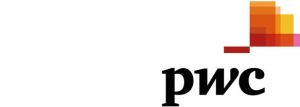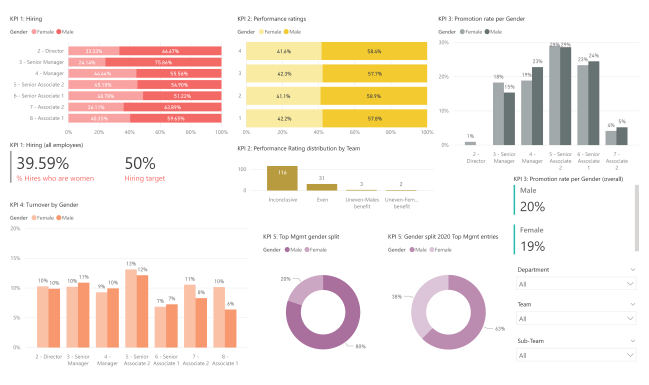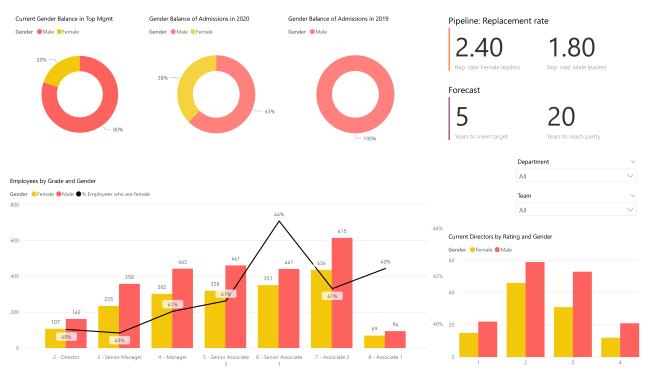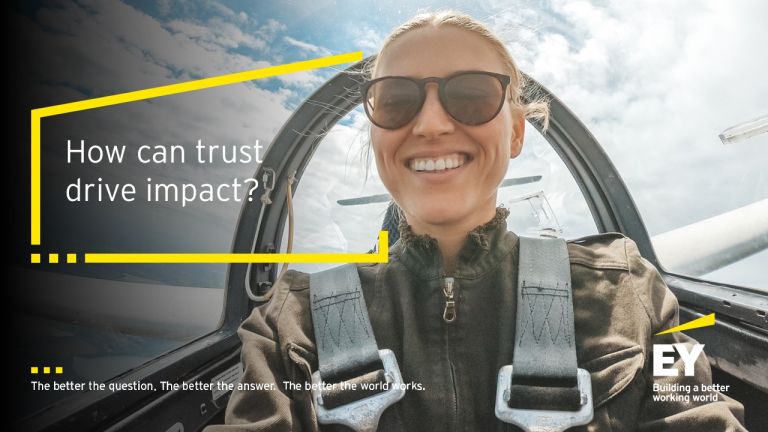Data Tells the Story as The PwC Switzerland D&I Dashboard Demonstrates | Best Practice by PwC Switzerland
PwC Switzerland’s D&I dashboard is designed to support data driven decision-making from a D&I strategy perspective, at the level of HR and Top
Management. The concept first came about as a tool for PwC Switzerland’s internal D&I planning and monitoring. It proved to be a highly effective means for securing Top Management engagement and ownership of PwC Switzerland’s D&I initiatives. As a result, PwC Switzerland made it available outside of the organization as well.
This best practice was first published in the Gender Intelligence Report 2020.
The dashboard is offered in Microsoft Power BI software and is designed to be highly interactive. While the current visualizations have served us well, the D&I topic and the demands from Top Management are evolving fast. For this reason, we have applied a design thinking approach to prototyping and testing the dashboard to allow us to build in new visuals, alternative metrics or additional aspects of diversity as our needs evolve.
The introduction of a new HR system provided us with a window of opportunity to make the case for a new D&I dashboard. We wanted to ensure access to real-time D&I analytics in order to inform, monitor and assess our D&I actions. These analytics are:

Senior Manager Culture & Change at PwC Switzerland

The lockdown served us as we could use it to take time for thinking, building and testing. We made use of our own D&I and data analytics capabilities to build a D&I dashboard exactly suited to our needs while incorporating best practices learnt from exchanging with other organizations.
It is built on known metrics used within the firm. These include KPIs tracked globally and at European level by our network of firms, as well as KPIs we monitored in the context of our regular management reviews; this notably included KPIs recommended as part of the EQUAL-SALARY Certification process. It posed an interesting challenge to find a way to make the dashboard both comprehensive in its content and intuitive to use. To find the right balance, we used an agile approach where we did not spend time in lengthy meetings to conceptualize the dashboard. Instead, we started building it based on a short brainstorming session, democratized a beta version, and continuously improved subsequent versions of the dashboard using design thinking and based on iterative feedback from user-stakeholders.

Summary tab for gender diversity metrics, demo data, PwC Switzerland 2020
The D&I dashboard provides insights at firm level but also by department, unit and even team level. It allows for trend analysis thanks to access to historical data going back 3 to 5 years. This was a challenge we had to overcome as the new HR system meant that historical data was not readily available, so we had to access it via two different systems. It was worth it – having historical data is the only way to track real progress against D&I KPIs. And we went a step further. We incorporated a predictive functionality, which allows us to understand the future impact of our past and current decisions and take preventive, preemptive and corrective actions where needed.
The D&I dashboard is used to inform our regular D&I strategy update meeting with the senior leadership. Since we have been showing such comprehensive data the frequency of these meetings has increased from once a year to quarterly.
The dashboard provides insights into key HR processes, enabling a data-driven approach in deep-dive sessions with the different HR teams (e.g. recruitment, talent management). Departments and units are compared against each other in terms of D&I progress using input from the dashboard, which is increasing leaders’ felt personal accountability for D&I. It has helped us to prioritize areas for further improvement and has helped us to learn from those parts of the firm that are most advanced in creating sustainable diverse and inclusive teams.

Diversity by grade and gender, demo data PwC 2020
If you are interested in learning more, please do contact Jasmin Danzeisen at jasmin.danzeisen@ch.pwc.com.
This best practice was first published in the Gender Intelligence Report 2020.

If CEOs are value-driven they make Diversity, Equity, and Inclusion a strategic focus area. By trusting and supporting their leaders to authentically champion these initiatives, the organization is able to foster a positive culture, improve performance, and achieve success.
When leaders are empowered to pursue their beliefs and values, they can lead with authenticity, integrity, and purpose, resulting in positive impacts on the organization.

Learn how Swiss Re is enabling leaders to incorporate inclusion into daily practice and to foster an inclusive environment where everyone feels valued.

Syngenta's Female Sponsorship Program is aimed at building a solid pipeline of female tech leaders within the company and the industry. Through tailored connections, support for global relocations, and tangible career advancements, the program has already made a noticeable impact on the careers of 18 talented women.

How can you push gender equality in the right direction at a faster pace? At Bain, a sponsorship program is key for ensuring the top management pipeline and retaining female leaders.

SIX launches SPI Gender Equality Index for Switzerland, aligning their core business activities with their D&I Strategy.

48% of all PM Switzerland’s management level employees were women in 2020, smashing the target of 40% by end 2022.

Dow's Sponsorship Program is de-biased by self-nomination and busts the myth that 'there are no eligible women'

Change doesn’t happen overnight but by integrating top & grassroots initiatives @Citi successfully builds an inclusive culture.
"NextWave” holds leaders accountable for creating and embedding an inclusive culture.

The CEO and senior leaders publicly advocate diversity and inclusion as business imperative.

Eye-opening sessions for male leaders to understand the challenges that women face in their careers.